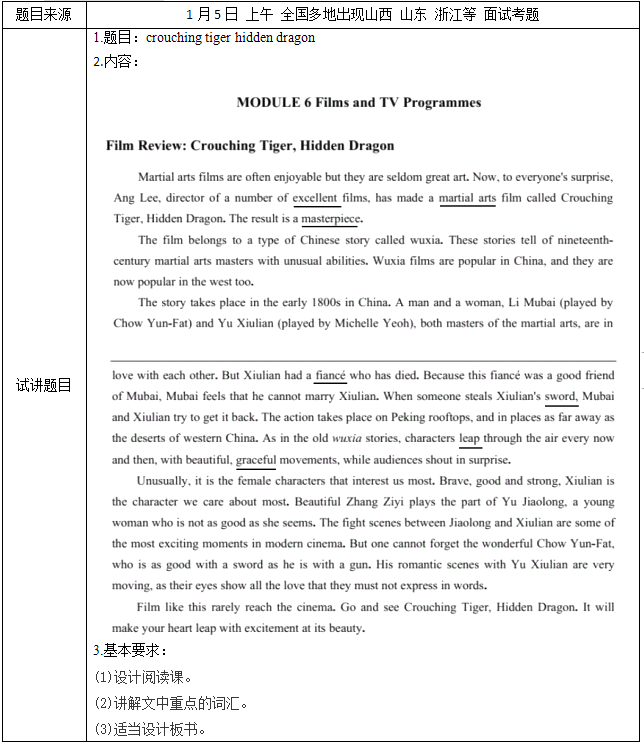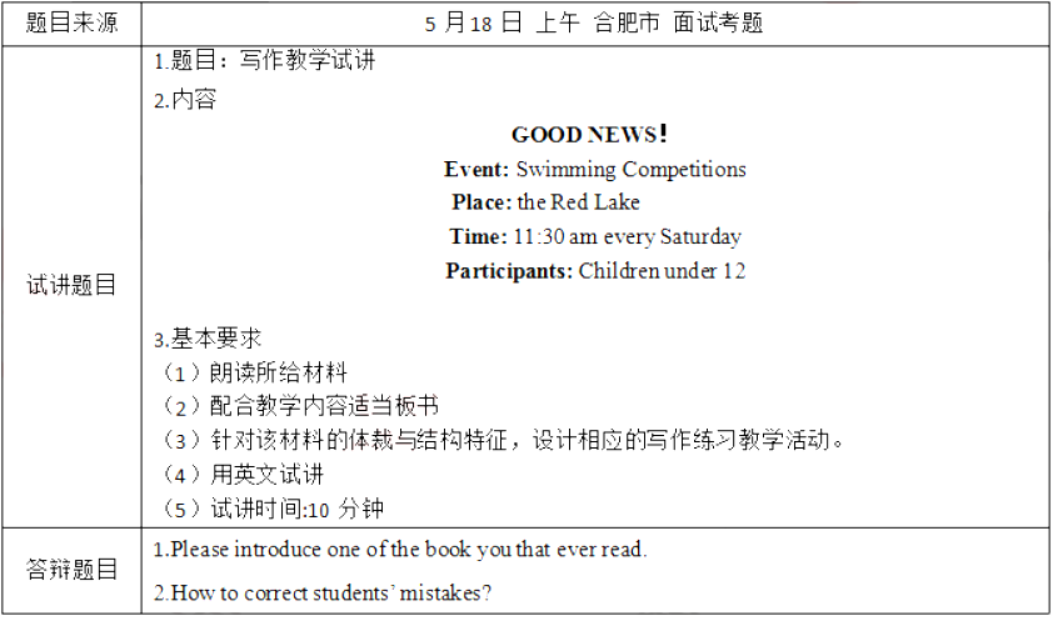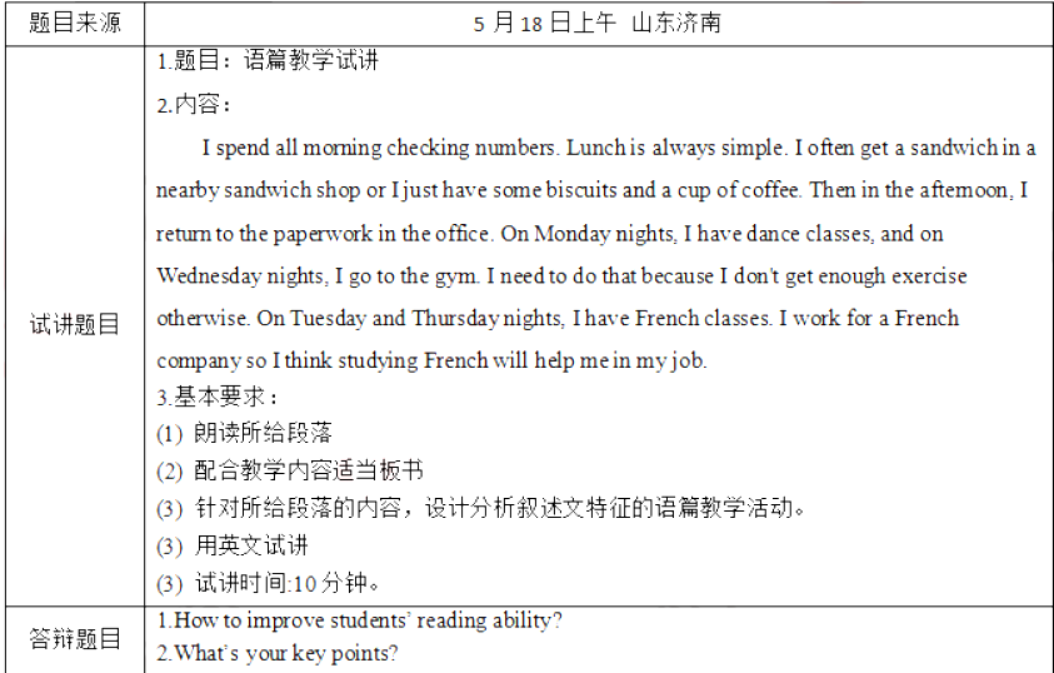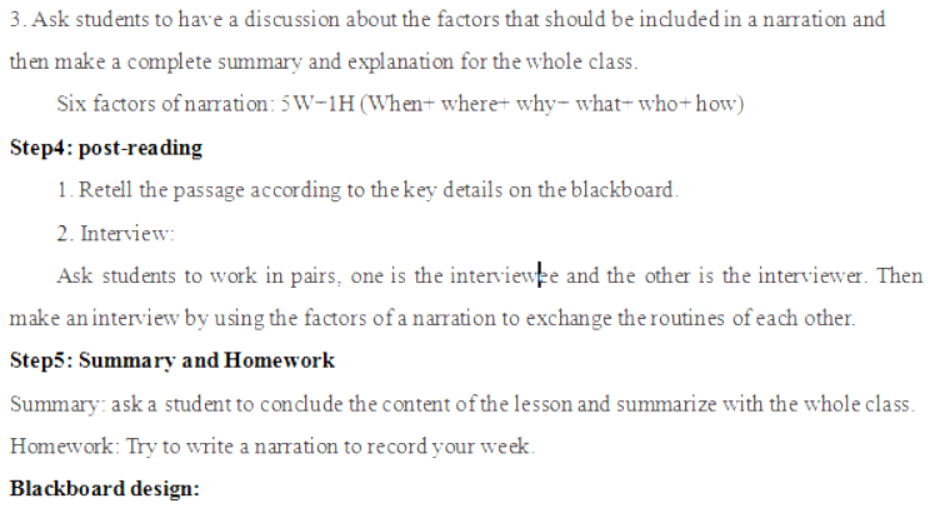高中英语?阅读 一、考题回顾二、考题解析 【教案】 Teaching aims: Knowledge aim: (1)Students are able to distinguish the words and Expressions and comprehend their meanings in sentences and paragraphs:leap,enjoyable, graceful,excellent, Martial arts etc. (2)Studentsunderstand thi
题目
一、考题回顾

二、考题解析
【教案】
Teaching aims:
Knowledge aim:
(1)Students are able to distinguish the words and Expressions and comprehend their meanings in sentences and paragraphs:leap,enjoyable, graceful,excellent, Martial arts etc.
(2)Studentsunderstand this review and make a film review.
Ability aim:
(1)Students can guess the meaning of new words and phrases while reading, understand what this review is talking about.
(2)After this lesson, students can learn how to write a review about films by using the words and expressions learnt.
Emotional aim:
Students are able to love learning English after this lesson
Key and difficult point:
Key Point: Learn to make a film review based on: director, plot, setting, characters, and actors and develop the reading skill of fast reading and scanning.
Difficult Point: Learn the reading skill of scanning for the specific information of the text and to be able to make a review in writing by the words they learnt.
Teaching procedure:
Step 1: Warming-up
1. Greetings.
2. Show the English trailer of Crouching Tiger, Hidden Dragon and ask students several questions:
Do you like watching movies?
What’s your favorite movie?
Do you want to know more about this film after watching this video?
Step 2: Pre-reading
1. Introduce the topic: Film Review Crouching Tiger, Hidden Dragon
2. Present vocabularies in PPT about Crouching Tiger, Hidden Dragon and then the teacher will ask several questions. The teacher will give the new words and explain new words with sentences.
How does this person looks like?
Is she or he happy or anything else?
Could you please give me some word to describe it?
What does this word means?
3.After learning new words, Give students a table and help them study movie types. At the same time, give students the words about types of film (Romantic film; Martial arts film; Adventure film; Thriller; Comedy); and then show representatives one by one: Titanic; The ShaoLin Temple; Kung Fu Panda; and Bean; last show the definitions

Step 3: While-reading
1.Fast reading: ask students to read the text fast and choose a best summary of this review.
Check the answers.
It is a martial arts film that tells the story of a stolen sword, and the fight to get it back.
2.Careful reading: ask students to scan and read the text again, then discuss the questions:
Discuss the following questions.
When did the story took place?
Where did the story happened?
Who are the main characters in this film?
What this story is talking about?
And then ask students to discuss the reasons why LiMubai did not marry Yu Xiulian, and whether they should get married? Invite two students express ideas in class.
Step4: Post-reading
1. Retell: Ask students to use the words and expressions learnt to retell part of the story according to following clues;
Li Mubai friend love
Yu Xiulian fiancé sword
Yu Jiaolong young woman
2. Discussion: Ask students to choose one of the favorite characters based on the introduction of the text and explain why in their own words. Then find some students to describe one character in public and give students feedback on their performance.
Step5: Summary and Homework
Summary: ask a student to conclude the content of the lesson and summarize with the whole class.
Homework: write a review on your favorite film more than 100 words.
Blackboard design:

1.What's your favorite sports?
2.Please introduce yourself
相似考题
更多“高中英语?阅读 ”相关问题
-
第1题:
- 教师资格考试高中英语教师说课要注意哪些事项?
说课是用英语的,不过你不用紧张。因为说课之前会给你题目,给你时间写教案,教案也是要交的哦!你可以多带基本书,可以带教参的,一般都是写高一的。写完了才说课,就按你写的说 就行,也不用背着说。说的过程要写板书,简单写就好了。去之前我也紧张,后来发现比想象的简单哦!面试会有提问的,用纸写的问题,如果你教过课就应该没问题的。都是给学生讲的那些问题。祝你顺利过关!
-
第2题:
- 我要考新乡高中英语教师资格证的说课,有没有前辈能给指导一下啊?
Module 1 Unit 2 Heroes Lesson 1 Modern Heroes
说课教案
(一) 教学内容
1. 本课是Unit 2 heroes Lesson 1 Modern Heroes 的第一课时。本单元分别介绍了National hero, History makers,Sports stars 和 Superhero。这几篇文章的主题都是hero,但涉及的领域不同,它们融会贯通,承上启下,融为一体。
2. 本课是介绍National Hero,是学生比较熟悉和感兴趣的话题,前部分需要介绍杨利伟和神州五号,让学生掌握有关词汇;后一部分是介绍杨利伟乘坐神州五号宇宙飞船遨游太空的情况。
3. 本课文出现了较多的定语从句,还有生词较多(有些单词表没有而初中又没有学过),在这样的困难前提下,我引导学生通过 culture and background knowledge,结合课本内容丰富自己的知识面,拓宽学生对航天知识的了解,让学生了解航天英雄的成功之路,激发他们的民族自豪感。
(二) 学生分析
1. 组成情况
职业高中高一学生年龄都在14-16岁之间,大多数学生由于初中的知识基础打得不扎实,而且缺乏主动学习的能动性,自学能力差,对学习没有持有探究性和方向性,也没有养成良好英语学习习惯,所以学习成绩不太理想。
2. 学生的知识与技能水平
职业高中招生的学生,基础知识比较薄弱,甚至连音标都不会读,词汇的掌握范围狭窄,影响了阅读,听力和作文。学生的表达能力还是停留在比较低级的水平,面对每幅图片或某个主题只能说出一两句话,而且在阅读上,未能掌握泛读和精读的技巧和方法,课后的预习和复习能力较差,缺乏总结归纳的能力。
3. 学生已掌握的学习策略
尽管学生的知识和技能水平一般,但经过了一定时间的训练后,他们还是掌握了pair work, group work, using the culture and background knowledge的阅读技巧。
(三) 教学目标
1. 通过快速阅读文章,学生能够对每段文章进行归纳总结,准确地把段落主题与所给的headings联系起来。
2. 通过仔细阅读,学生能够回答关于文章的细节问题。
3. 通过进一步阅读,学生能够学生能用英语对采访自己心目中的民族英雄。并尝试复述课文。
(四) 教学策略
教学方法:使用交际法,充分调动学生的积极性,积极参与到课堂教学中,通过师生互动,小组表演的形式,完成各种任务,以达到完成教学任务的途径。
(五) 教学过程
第一步 导入
T: Good morning, Everyone! Do you like watching movies? Do you know Jet Lee (李连杰)?Do you know one of his famous movie called HERO? What does ‘hero’ mean? Who are the heroes in your heart? Do you know Yan Liwei, our national hero?
第二步 介绍文章人物
T: Open your books, and turn to page 100 and 101. Let’s read two passages about Shenzhou V and Yang Liwei.
Shenzhou V is China’s first manned spaceship. It lifted off at 9 a.m. on Wednesday, October 15th, 2003 in Jiuquan, Gansu Province. It was carrying Yang Liwei. It was launched very successfully and landed in Inner Mongolia safely.
Yang Liwei is China’s first astronaut. He was a pilot in the army. He was chosen from 1,500 other army pilots and started training for his space flight in 1998. During the 21-hour space flight, he circled the earth 14 times. When the spaceship was doing its seventh circle, Yang Liwei showed the flags of China and the United Nations, expressing the wishes of the Chinese people to explore and use space peacefully.
介绍文章时,展示文章中的生词,让学生猜测词意,带读并加以巩固。
第三步 阅读文章
(1) Fast Reading
呈现六个headings,让学生快速阅读,要求归纳每段的主题。
a. Astronaut lands safely
b. Welcome home
c. International good wished
d. An exciting lift-off
e. Introdution
f. During the flight
学生单个回答并集体讨论改正错误。
(2) Careful Reading
学生通过fast reading,完成了headings后,基本对课文有一定的了解,然后呈现出五道问题,要求学生再进行第二次阅读,对课文进行更深入的了解。
1. How did Yang Liwei feel duing the flight? How did he feel afterwards?
2. What did Yang Liwei do during the Shenzhou V’s seventh circle of the earth?
3. How many circles did the spaceship complete while Yang Liwei was sleeping?
4. What were helicopters doing as Yang Liwei returned to the earth’s atmosphere?
5. What did Yang Liwei do when he came out of the spaceship?
第四步 巩固练习
通过两次阅读让学生对课文熟悉,训练学生的阅读速度和解题技巧,最后通过ask and answer in pairs,培养学生的口语能力,并强迫他们记住文章的主要内容,为下一步语言运用打下基础。
第五步 语言运用
为提高学生对生活中的热点问题发表自己观点的能力,让学生运用自己学过的语言知识,对自己心目中的民族英雄进行模拟采访。把全班同学分成若干个小组,每个小组有一名同学扮演“杨利伟”,其他同学为全国各地新闻媒体记者,他们自由设计问题,对“杨利伟”进行采访。
教师巡视课堂,发现表现出色的小组,让他们到台前表演。
教师总结评价。
第六步 布置作业
让学生准备复述杨利伟的故事,要求说出自己的民族自豪感。
A Teaching Plan for Unit 3 Celebration Lesson 1 Festivals
HUANG SHUI PING
General objectives:
1.To read to learn the main Chinese seasonal festivals and their history origin and meanings.
2.To help them learn some phrasal verbs and functional items about the topic and try to use them.
Language aim:
1.Phrases:
Be celebrated by, fall on , mark, be decorated with, tradition/traditional, serve, take part in, get together
2.important sentences:
The Mid-Autumn Festival is celebrated by Chinese people.
The Lantern Festival falls on the fifteenth day of the first lunar month.
It marks the beginning of the hottest season of the year.
Ability aim:
1).Improving the ability of getting the general information and specific information from reading a text.
2). Using own words to describe some important Chinese festivals.
Emotion aim:
To promote students’ qualities of a patriotism(爱国主义精神,爱国心) by learning the main Chinese festivals and learn their history origin and their meanings。
Teaching important points and difficult points:
1).To get information from reading
2).To talk about festivals freely in English.
Teaching methods:
Brainstorming, task-based teaching method , heuristic teaching method , group work.
Teaching aids:
a recorder, a computer, and blackboard
Teaching procedures:
Step1. Greeting and reviewing.
Greet the class as usual.
Ask: what we can celebrate in our life? Get students to answer using the key words in warming up. eg,
Graduation, a birthday, Christmas, passing an exam, winning a scholarship, a sporting victory, the Mid-Autumn Festival, the New Year, a wedding, Halloween, the Dragon Boat Festival
Step2. Leading-in.
Show students many pictures of different seasons on the screen , asking: What’s your favourite season? Why? Help students answer using the words that they have already learned. Then ask: What festivals happen during your favourite seasons? Show more pictures about different festivals on the screen to help them to answer.
Students can work together to answer this question. Eg,
T:What is your favorite season? What festivals happen during your favorite season? ( have a discussion)
(S1: I liker summer. There are Children’s Day, Dragon-boat Festival and Mother’s Day.
S2: My favorite season is winter. They are Spring Festival and Lantern Festival and Christmas Day.
S3: ……
T:Well done. Thank you.
Explain the differences between Day and Festival.
Step3.While-reading
Activity1.Fast-reading
Get students to read the text quickly, match the pictures with the festivals.
Activity2. Guessing.
Show some describing sentences on the screen to let students read and guess the names of the three festivals .
Activity3. Careful-reading
This time let students read the text carefully and get more detailed information to fill in the table of exercise3 on page36.
Ask some students to report their answers to the class.
Step4. Practice
Play the tape for the students to listen and ask them to fill in the blanks according the text.
1.The Mid-Autumn Festival happens in September or______. it is important because it is a special _____ for family.
2. There are many different kinds of mooncakes ____ fruit, coffee, chocolate and so on.
3. The ____ ____ Festival falls on the fifth day of the fifth month of the lunar year.
4.The Dragon boat race marks the _____ of the hottest season of the year.
5.________Festival marks the end of the Chinese New Year celebration.
Step5. Post-reading.
Let students discuss with a partner and answer the following question.
Which festival in China is most important for children? Young people? Old people? Women and men?
Then ask some students to give a report.
Step6. Homework.
1. do the exercise 9 on Page 37
2. remember the new words in Lesson One.
3. use your own words to describe a festival that you are familiar with.
Step7. Blackboard design.
Lesson 1 Festivals
The Mid-Autumn Festival is celebrated by Chinese people.
The Lantern Festival falls on the fifteenth day of the first lunar month.
It marks the beginning of the hottest season of the year. -
第3题:
高中英语教学内容的特征有哪些?答案:解析:相对于初中英语,高中英语的难度在各个方面都得到了提升。对特征类型要特别注意。
-
第4题:
高中英语 写作
一、考题回顾
 答案:解析:二、考题解析
答案:解析:二、考题解析
【教案】
Teaching aims:
Knowledge aims:
Students can master the structure of notice.
Ability aim:
Students can improve their abilities of collection and organization.
After this lesson, students can write some notice in their daily life.
Emotional aim:
Students are able to get the confidence of learning English.
Key and difficult point:
Key Point: Master the structure of notice.
Difficult Point: Students can gain the ability of writing some notice in their daily life.
Teaching procedures:
Step 1: Warming-up
1. Greetings and talk weather with students.
2. Homework : Ask students to share the homework for last class “ write a letter to your pen pal”. and think of the structure of letters.
3. Introduces some different forms of writing.
4. Lead to the new lesson, notice.
Step 2: pre-writing
1.Ask students to read the small article on the screen. Then ask student “ What’s this article talking about?” And tell them it is a good news. And the ask them “Do you know the writing style of this article?” Then tell them it is a notice.Then ask them”Do you know how to write a notice?”
2.Then ask student to find some key segments about the notice.
3.Then help them to conclude the structure of notice:
Event,place,time and participants
4.Ask students to think, how to write a notice about “student union will hold a singing competition.”
5.Show the materials on the blackboard:
Event: Singing competitions
Place: The fist dining hall
Time: 9 a.m. to 5 p.m.,next Sunday
Participants: all the students
Step 3: While-Writing
1. Give students 15 minutes to write a notice with the collected writing material.
2. When students are writing, correct their spelling and grammar.
Step 4: Post-Writing
1. Peer-editing: Ask students to check their notices with their deskmates.
2. Sharing: Invite some students to share their notices.
3. Give the evaluation according to their notices.
Step5: Summary and Homework
Summary: Ask a student to conclude the content of the lesson and summarize with the whole class.
Homework: Improve their works after class.
Blackboard design:


Reading books can make us a full man. I like reading during my spare time. Now I want to introduce you one book that I have ever read. It is called One hundred suggestions for a teacher, written by Suchumlinskii. I think I really learned a lot from it. It mainly tells us some good ways to be a good teacher, for example, we should love our students, respect the uniqueness of them,
and keep learning. Some of them are stilled call for by modern educationist. I use some of them into my teaching, I find they are really useful. I think every teacher can read this book and learn how to be a good teacher from it. If I had a chance to be a teacher, I would learn from it, learn from other experienced teachers, always try to be a better teacher.
1. How to correct students’ mistakes?
【参考答案】
Students may make some mistakes during their process of learning, but as for hoe to correct their mistakes, it is an art. Students in this age like being praised by teachers and do not want to be blamed for their mistakes. I think they are many ways to correct their mistakes, for example, explicit correction,recast,pinpointing and so on. Here I want to introduce one that I am used to applying during my teaching, that is, elicitation. we can ask the students “how do we say...in English”, then we can lead the students to answer the questions continuously by gestures or eye sight. When the student cannot correct it , I can ask other students to correct it for him or her. In this way, the students can know the mistake more deeply. -
第5题:
依据《普通高中英语课程标准》,为有效地发展学生的思维与表达能力,在教学过程中教师可采用图表的方式帮助学生组织信息, __________,发表见解,开阔阅读和写作活动。答案:解析:表达观点 -
第6题:
普通高中英语课程具有什么样的特点?()
- A、基础性
- B、多样性
- C、选择性
- D、普适性
正确答案:A,B,C -
第7题:
发展学生的语言能力及其批判性思维是普通高中英语课程的具体目标。
正确答案:错误 -
第8题:
笑话不属于普通高中英语课程语篇类型内容要求之一。
正确答案:错误 -
第9题:
高中英语和必修课程应掌握()个单词,累计达()。
- A、500,2000
- B、200,3000
- C、100,4000
- D、365,4500
正确答案:A -
第10题:
判断题发展学生的语言能力及其批判性思维是普通高中英语课程的具体目标。A对
B错
正确答案: 对解析: 暂无解析 -
第11题:
单选题2016年我国成年国民数字化阅读四个方式的接触率按从高到低排列正确是:A网络在线阅读>手机阅读>电子阅读器阅读>平板电脑阅读
B手机阅读>网络在线阅读>电子阅读器阅读>平板电脑阅读
C网络在线阅读>手机阅读>平板电脑阅读>电子阅读器阅读
D手机阅读>网络在线阅读>平板电脑阅读>电子阅读器阅读
正确答案: B解析: -
第12题:
单选题高中英语学业质量水平中,水平一是高中学生在英语学科应达到的合格要求,也是()命题的主要依据。A英语高考命题
B高中英语学业水平考试命题
C高中英语测评命题
D其他相关考试
正确答案: A解析: 暂无解析 -
第13题:
阅读能力的结构包括()A.积累性阅读与阅读感知力。
B.理解性阅读与阅读理解力。
C.欣赏性阅读与阅读审美力。
D.研究性阅读与阅读评价力。
E.创意性阅读与阅读创造力。
F.“信息阅读”。
参考答案:ABCDEF
-
第14题:
设计任务:请阅读下面学生信息和语言素材,设计20分钟英语阅读的教学教案没有固定格式,但须包含下列要点:
●teaching objectives
●teaching contents
●key anddifficult points
●majorsteps and time allocation
●activities and justifications
教学时间:20分钟
学生概况:某城镇普通中学高中一年级学生,班级人数40人。多数学生已达到《普通高中英语课程标准(实验)》五级水平。学生课堂参与积极性一般。
 答案:解析:Class Type:ReadingClass
答案:解析:Class Type:ReadingClass
TeachingContents:The lesson mainly talks about the ThreeGorges Dam, including its features, advantages and disadvantages.
Teaching Objectives:
Knowledge objective
Students can get more information about the features, advantages anddisadvantages of the Three Gorges Dam.
Abilityobjectives
(1)Students can understand the main content and detail information ofthe passage through fast reading and detailed reading.
(2)Students can introduce the Three Gorges Damin their own words.
Emotional objective
Students can develop a sense of national pride through learning thispassage.
Teaching Key and Difficult Points:
Studentscan get a general idea of the passage and learn to use reading strategies tounderstand the material, such as summarizing, skimming and acquiring usefulinformation
Major Steps:
Step1 Pre-reading (5 minutes)
1. Show a poem of Mao Zedong on PPT:Walls of stone to hold back clouds and raintill a smooth lake rises in the narrow gorges.Students guess which placeit is. Then show some beautiful pictures of the Three Gorges Dam.
2. Students have a discussion: Why did weChinese build the Three Gorges Dam Then ask some of them to share their ideas.
(Justification: The poem and pictures canarouse students' interest in this class. Discussion will stimulate students’ backgroundinformation and students will get prepared for the reading class, and it willbe helpful to understand the material. )
Step 2 While-reading (9 minutes) .
1. Fast reading: Task 1 : Students read the passage quickly and give asummary of each paragraph. Students share their ideas and help students toanalyze the article structure.
2. Careful reading: Task 2: Students read the passage again and completethe following table. Then ask some students to show their answers and giveassessments.

Task3 : Students pay attention to Paragraph 2-5, and work in pair s to discuss thequestions below:
(1) What's the biggest advantage of the Three Gorges Dam project
(2) What has happened to the historical relics near the Three GorgesDam
Ask some pairs to show their opinions and lead students t0 1eam thenecessity of the Three Gorges Dam.
(Justification: Through three tasks, students can have a thoroughunderstanding of the passage, and improve reading skills by using different readingstrategies: such as summarizing and acquiring useful information.)
Step 3 Post-reading (6 minutes)
Interview: students work in a group of three. Two students act asengineers from the Three Gorges Dam and one student as a reporter. The reporterasks some questions about the Three Gorges Dam and their feelings about the constructionproject. After three minutes, invite some groups to show their dialogues.
(Justification: Students can improve their speaking ability by talkingabout the Three Gorges in their own words and develop a sense of national pride.) -
第15题:
高中英语 阅读
一、考题回顾
 答案:解析:二、考题解析
答案:解析:二、考题解析
【教案】
Teaching aims:
Knowledge aims:
(1) Students are able to understand the content of the passage.
(2) Students can know some basic information of narration.
Ability aim:
Students can use different basic reading strategies like analyzing, grasping details correctly in their reading process.
After this lesson, students can write a narration by themselves.
Emotional aim:
Students will be more willing to get involved in class activities and boost their interest in learning English.
Key and difficult point:
Key Point: understand the characteristics of narration.
Difficult Point: improve students’ learning interest and write a narration by themselves.
Teaching procedures:
Step 1: Warming-up
1. Greeting.
2. Have a free talk:
Ask students some questions about their weekend. For example,
1). Did you enjoy your weekend?
2). What did you do on your last weekend? And how about your week days, what did you do?
3.Then ask students to answer the questions and give them some feedback. Then tell them I have friend John he had wrote a short passage to describe his week, and ask my students if they want to know his week or not to lead in the topic of today: “My week”.
Step 2: Pre-reading
1.Prediction.
Ask students to make a prediction about what John does during his week and invite some students to share their ideas.
Write down some of their answers on the blackboard to recall some related words and give evaluation to the students.
Step 3: While-reading
A. Extensive reading
1.Let students to read the passage for the first time. Ask students a question: What does the passage talk about? (This passage talks about the week of the writer)
2.Then invite one student answer the question and give evaluation.
B. Intensive reading
1.Ask students to read the passage for the second time and finish the exercise on the blackboard:
1). John’s lunch is diversified. (T/F)
2). When does John return to the paperwork in the office?
3). What does John do on Monday nights?
4). Where does John go on Wednesday nights?
5). Why does the author study French?
…
2.Then invite two students to answer these questions separately and give evaluation. Write down the right answers on the blackboard.



Reading ability plays a very important role in the process of learning. It is an important part of students’ overall ability. If we want to communicate with others, we should understand what someone is saying. So as a teacher, we should try our best to help students improve their listening ability.
First, before reading, we should lead the students to get familiar with the topic and the potential new words, so that the students can listen to it more smoothly. Besides, we can ask the students to make a prediction about the main idea of the passage to arouse their interest. During reading, we can train students’ reading ability by letting students read for different purposes, for example, getting main idea by extensive reading and getting some detail information by intensive reading. After reading, in order to make students get more familiar with the topic, we can organize some group work, such as, discussion, debate, survey, retelling and so on. After class, we can also give them some reading related homework to have them practise listening.
I hope students can finally improve their reading ability through the above methods.
2. What’s your teaching aims?
【参考答案】
According to the new curriculum standard, I set the following teaching aims:
The first one is knowledge aims: (1) Students are able to understand the content of the passage. (2) Students can know some basic information of narration. The second one is ability aims: Students can use different basic reading strategies like analyzing, grasping details correctly in their reading process. After this lesson, students can write a narration by themselves.The third one is emotional aim: Students will be more willing to get involved in class activities and boost their interest in learning English. -
第16题:
依据《普通高中英语课程标准》,高中英语教学要鼓励学生通过积极尝试、自我探究、自我发现和__________ 等学习方式,形成具有高中生特点的学习过程和方法。答案:解析:主动实践 -
第17题:
依据《普通高中英语课程标准》,语言有丰富的文化内涵。教师应根据学生的年龄特点和__________ ,逐步扩展文化知识的内容和范围。答案:解析:认知能力 -
第18题:
普通高中英语课程标准提出了()构成的课程内容以及英语学习活动观。
- A、四要素
- B、五要素
- C、六要素
- D、七要素
正确答案:C -
第19题:
普通高中英语课程具有()的特点。
- A、工具性和人文性
- B、工具性和科学性
- C、科学性和人文性
- D、人文性和多元性
正确答案:A -
第20题:
高中英语学业质量水平中,水平一是高中学生在英语学科应达到的合格要求,也是()命题的主要依据。
- A、英语高考命题
- B、高中英语学业水平考试命题
- C、高中英语测评命题
- D、其他相关考试
正确答案:B -
第21题:
判断题笑话不属于普通高中英语课程语篇类型内容要求之一。A对
B错
正确答案: 对解析: 暂无解析 -
第22题:
单选题普通高中英语课程标准提出了()构成的课程内容以及英语学习活动观。A四要素
B五要素
C六要素
D七要素
正确答案: A解析: 暂无解析 -
第23题:
判断题高中英语教材只需要确保高中学生通过英语课程的学习掌握新课标规定的内容。A对
B错
正确答案: 对解析: 暂无解析 -
第24题:
单选题2016年我国成年国民数字化阅读四个方式的接触率按从高到低排列正确的是:A网络在线阅读手机阅读电子阅读器阅读平板电脑阅读
B手机阅读网络在线阅读电子阅读器阅读平板电脑阅读
C网络在线阅读手机阅读平板电脑阅读电子阅读器阅读
D手机阅读网络在线阅读平板电脑阅读电子阅读器阅读
正确答案: A解析:
